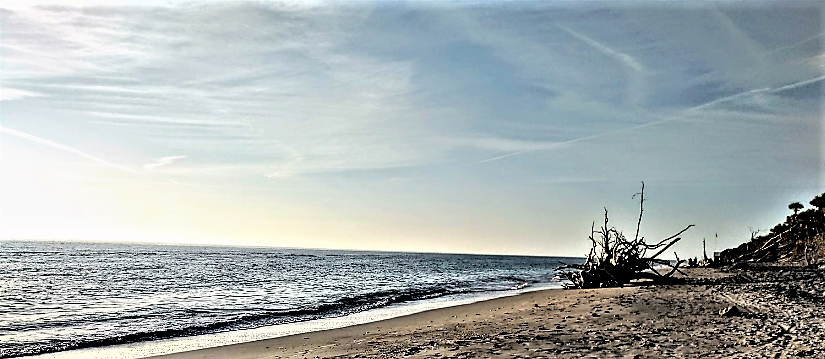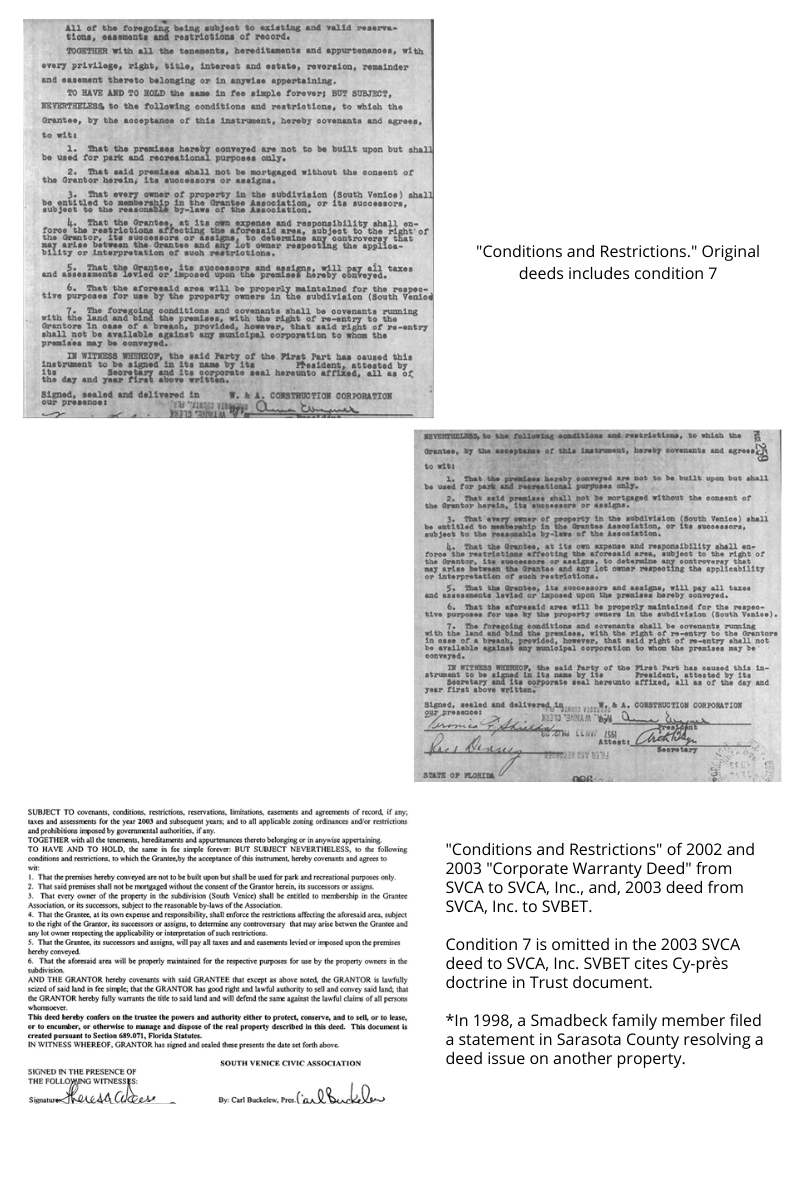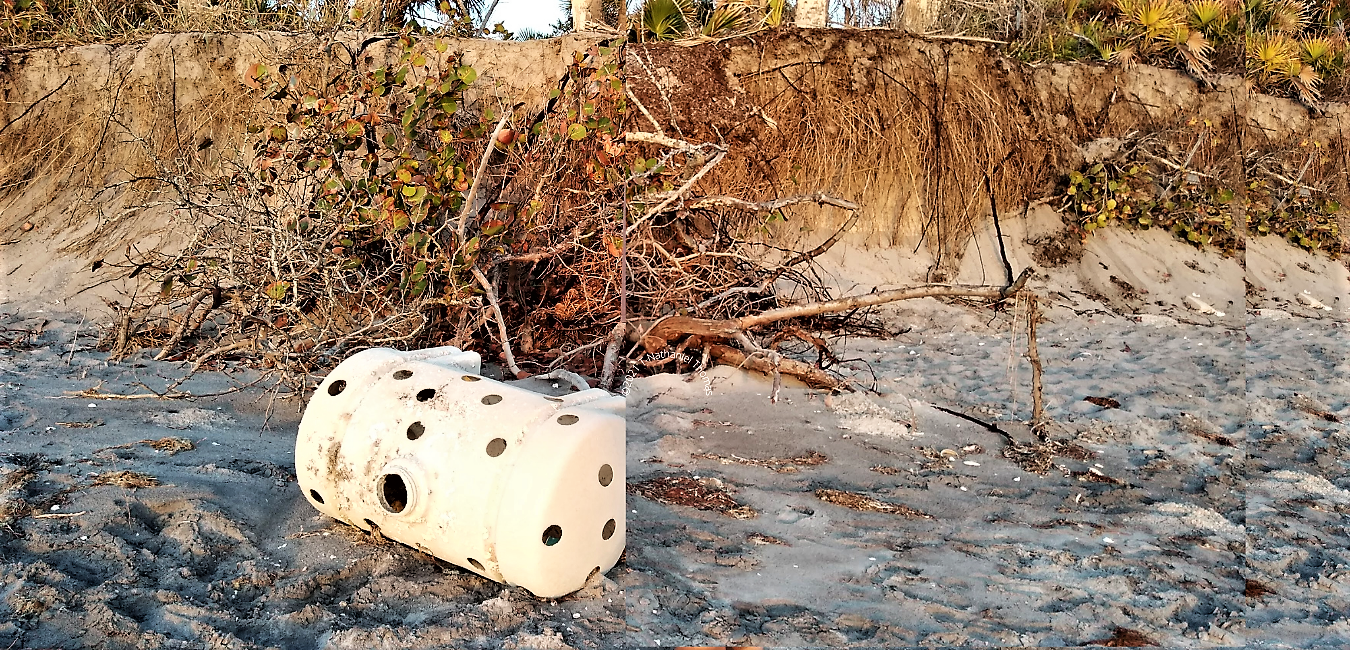Writer’s Notes: I live close to South Venice Beach and its related properties. And, I have a good deal of personal knowledge about the community and its history. These stories, however, are not the product of my opinions nor are they based on my objectives. I am writing for my community, first, for you, whether or not you live here, and for the sole purpose of giving information. What is made of what is read here will vary. That is a reasonable diversity of reactions. If these stories inform, educate, or add something new to the reader's understanding, then my work has succeeded. - KyleeliseTHT
*Historical documents, photographs, interviews and information, and records provided and used courtesy of Westcoast Inland Navigation District, Venice Museum & Archives, Sarasota County Government, Sarasota County Sheriff's Office, South Venice Beach Endowment Trust, and area citizens. The writer thanks all for access to these materials, information, and time. The writer also thanks participating community members for their time and candid interviews.

THE PROMISE OF A FOREVER BEACH
Photographs and video © KyleeliseTHT and T-Nathaniel Thomas

Have the residents of South Venice, Fla. an ownership stake, implied or documented, or any control over what happens to or at the ferryboat park and South Venice Beach? There are short and long explanations that might clarify these questions.
Either way, the answer is mostly “No.”
No legal opinions are implied in this article or by this writer—just observations of words written on ostensibly binding documents.
While the language in the South Venice Beach Endowment Trust document includes holding onto the properties “in perpetuity” and “for public benefit,” there are allowances written to the contrary.
The South Venice Civic Association (SVCA) and the South Venice Beach Endowment Trust (SVBET) essentially appear to have softened over time the residents’ and property owners’ direct assurances through a series of deeded and organizational maneuvers from the May 2001 SVCA/SVBET Trust agreement through 2003 and 2004 in deeds from SVCA and SCVA, Inc. to SVBET.
Any language that remains indicating otherwise might just be purely unenforceable public relations.
More to the point, SVCA and SVBET nearly undid the very spirit of the Smadbeck/W & A Construction Corporation’s gifts by setting aside one of the “conditions and restrictions” in the original deed that might have protected the community assets from being severed from the residents and property owners of South Venice.

The Trust agreement document begins in alignment with the original intention, sans the one omission. It includes in the introduction, “By this Agreement, the Settlor establishes this Trust to take legal title to and hold and manage in perpetuity for public benefit and enjoyment of Community residents and property, all such assets and properties as legally described… ”.
The first item under “Trust Purpose and Assets” reiterates, “To hold, manage, and maintain in perpetuity all Trust Holdings and to provide them for public benefit and enjoyment of Community residents and property owners.”
But that one item that SVCA omitted from the 2003 and 2004 deeds to SVBET essentially voids the words “... to hold and manage in perpetuity for public benefit and enjoyment of Community residents and property.”
SVBET can sell the beach and ferry properties. And the monetary assets, including the $450,000 profit held in trust from the 2008 sale of property adjoining a local park in Sarasota County, can be redistributed to another entity.
Take the sale of the property to Sarasota County.
In a September 2008 affidavit signed by then SVBET Trustee Maureen Holland, she asserts, “The Trust currently is the owner of the following real property,...”.
Ms. Holland also affirmed that “The Trustees have the power to convey the real property held in Trust, and no amendment has been made to the Trust changing or negating this power.”
No longer exists a promise of a “Forever Beach” held “in perpetuity” for South Venice residents and property owners despite whatever guarantees the Smadbecks intended and SVCA initially upheld, either on paper or word of mouth.
In contrast to the opening paragraph of the Trust formation document, by page five, SVBET relied on a legal concept called Cy-près doctrine to dispense with the condition that SVCA had already omitted from the deeds by citing “the W. and A. Construction Company, as the original owner-developer of the South Venice subdivisions, as they were then known, and as the original Grantors and party to the deed covenants and restrictions, are both entities that no longer exist;..”.
Cy-près doctrine takes precedence when a party to an agreement cannot carry out an original condition.
Twenty-four years earlier, SVCA honored condition seven.
Condition 7 - the one omitted and to which the Trust document refers reads, “The foregoing conditions and covenants shall be covenants running with the land and bind the premises, with the right of re-entry to the Grantors in case of breach, provided, however, that said right of re-entry shall not be available against any municipal corporation to whom the premises may be conveyed.”
In the late seventies, early eighties, SVCA and Sarasota County brokered a land swap that would give SVCA contiguous Gulf frontage instead of the divided North and South beaches that were the original gift.
Author Vida Davis Hoffacker, a former South Venice resident, included a copy of two letters in her book, Our Little Corner of Florida.
On behalf of SVCA, a law firm contacted William Blayer.
In September 1977, Mr. Blayer, the vice president of Warren and Arthur Smadbeck, Inc., wrote in part: “We might be agreeable to permitting the property exchange between the Civic Association and the County. Before giving such approval, we would want to have a map showing the size and location of the Caspersen property to be taken in trade, and membership resolution by the association approving it.”
After Mr. Blayer’s inquiry was addressed, on February 15, 1980, he wrote, “Thank you for your letter of February 19th, explaining the reasons why the South Venice Civic Association favors the exchange of beachfront parcels with Sarasota County.
The reasons appear sound, and we consent to the implementation of the Agreement between the parties dated October 26, 1979.”
During a call with this writer, a descendant of Arthur and Warren Smadbeck said that deed matters are ongoing. Another family member handles them now.
The Smadbeck relative declined to give an interview. But, he did confirm the Smadbeck business model of partnering with a local newspaper or chamber to develop communities around lakes, parks, and in areas that were close commuting distances from urban centers.
The Venice Area Chamber of Commerce was the sales partner for W & A Construction Corporation.
The brothers developed communities in thirty states and built more than a half-million homes.
.How deep is the well of regret?
The Intracoastal Waterway is 3000 miles long and runs inland parallel to the Atlantic and Gulf of Mexico. Plans for the protected passageway grew out of a wartime act to survey transportation routes, known as the General Survey Act of 1824 that expanded through a series of Rivers and Harbors Acts to improve navigation.
The Intracoastal Waterway was established under the Rivers and Harbors Act of 1945.
The U. S. Army Corps. of Engineers managed the inland dredging that ran southeast from Texas along the Gulf of Mexico, south in Florida, then inland on the Atlantic side north to Cape Cod, Massachusetts.
The two South Venice footbridges that crossed over Lemon Bay were in the direct path of the dredging operation.
In the latter part of 1959, SVCA was made aware that the footbridges would have to come down to make way for the Intracoastal.
In June of 1960, Colonel Paul D. Troxler of the Army Corps of Engineers advised SVCA “not to relax” its “efforts of having the first bridge removed...” before work reached the site sometime after the initial date of July 1961.
But the residents of South Venice put up a fight, and the bridges remained in place.
The footbridges were the only means of walking inland from the South Venice and Sunset Beach subdivisions to South Venice Beach.
To try and keep them, SVCA and some residents lobbied government officials, waged letter-writing campaigns, and held a “sit-on” to try and disrupt the inevitable dredging through Lemon Bay.
What to do was a dilemma for the government.
“Our problem is that each one of the lot owners was guaranteed access to the private beach on the bay,” wrote Colonel George Kumpe, the executive director of WCIND
In May 1962, in “another call for help,” Col. Kempe wrote, “The Navigation District is faced with a problem of providing pedestrian access across the Intracoastal Waterway in order to eliminate a suit against some 6500 owners of a mail order development.”
Col. Kempe explored building a “pedestrian lift bridge” that would serve the residents of South Venice and not impede passage along the Intracoastal. After reviewing the Manhattan to Ward’s Island design, he decided it was “too elaborate.”
Such a bridge would need to have a clearance of 90 feet.
All sorts of remedies were considered, including a ski-lift type of crossing, various bridge types, and motorized vessels.
In 1962, West Coast Inland Navigation District sought eminent domain by “an order of taking” against South Venice Civic Association as a part of a larger scheme to clear the way from the Anclote River in Pinellas county southward to the Caloosahatchee River in Lee County.
The footbridges were still standing in 1963, despite numerous pleas and warnings.
In May 1963, South Venice Civic Association asked WCIN to consider a swing bridge.
When negotiations failed, WCIND took a different approach. Had the footbridges been permitted? But a letter from the Corps of Engineers dissuaded the tactic.
The Court granted the “order of taking” in 1964. The action led to the end of a 3-year legal battle and nearly six-year standoff.
The footbridges were removed in the summer of 1965. And, WCIND paid $150,000, plus legal fees, that South Venice Civic Association agreed “would provide in perpetuity access by ferry services to both beach areas to members of the South Venice Civic Association and any lot owners in South Venice Subdivision.”
Olaus Caspersen sued SVCA and WCIND over the settlement, claiming that only about ten percent of the more than 1000 residents voted, during the late-summer, out-of-season election. Only 90 residents voted in favor of the settlement, according to the lawsuit.
The Court dismissed Mr. Caspersen’s lawsuit. Ironically, in 1970, SVCA, dissatisfied with the deal it had championed, “sought congressional support” for a vehicle bridge.
Remorseful over the settlement, again, in 1993, SVCA asked the Court to interpret the meaning of the “in perpetuity” stipulation in section seven. Not to be confused with condition seven of the W & A Construction Corporation deeds.
Jim Armstrong, the director of WCIND at the time, viewed the request as a ploy for more money.
“It appears to me that item 11 of the stipulation is quite clear,” Mr. Armstrong wrote in a letter. “I question their legal position in even serving this summons. I don’t believe WCIND could care less as to when or how they spend or spent the $150,000.” He then added, “Please call (SVCA Attorney Jeffery) Boone and see what they really want, which is probably another $150,000!”
Boundless power is only as good as its consensus.
Sandy McHenry pressed her colleagues to a vote at a May 19, 2021, SVBET general meeting. By unanimous decision, the Trust appointed a new 3-person committee to lead an effort to save South Venice Beach.
After John Bridinger, who voted with the other members, resigned that evening, Ms. McHenry left, too, the next day.
The 5-member Trust was already down one. Mr. Bridinger and Ms. McHenry’s resignations left just two trustees - attorneys Ms. Cheryl Cooper and Mr. (Charles) Bauman.
In the months before, when the push to fence the ferryboat property and other proposed changes heated, Ms. McHenry drafted a survey.
“South Venice Community Survey Regarding Possible Substantial Changes That Would Affect You!!! (Please read and respond!).”
Ms. McHenry outlines a host of concerns and considerations, then asks two questions:
1 - Should ferry passes and boat ramp keys continue to be available for purchase for non-residents at double the cost of a resident rate in order to allow us to seek public funding?
2 - Would you support the installation of an entrance gate for individual entry of ferry pass and boat ramp key holders at 4800 Lemon Bay Drive?
The survey never gained enough support among the Trustees.
Ms. McHenry objected.
“The land was given by the developer, and all the homeowners in the community have ownership of this,” she said, adding, “I believe that the community should have input into what the Trust does so we know what they feel is best for the community. Although I realize that the Trust has final decision-making.”
The day before Ms. McHenry resigned, she urged the board to address another issue to no avail. But the refusal to take up the matter didn't make it go away.
The fence that SVBET put up and signs that the property is private and membership is required created a red-flag issue at the government level.
In a May 17, 2021 email addressed to SVBET and South Civic Association (SVCA), Joseph J. Kraus, Business Professional at Sarasota County Government, had questions about the fencing off of 4800 Lemon Bay Drive.
Two hundred sixteen thousand, nine hundred seventy-five Federal dollars ($216,975), managed by the West Coast Inland Navigation District and administered by Sarasota County, had been used to fund improvements to the ferryboat house and the boat ramp on the property and financed the 2017 dredging of the ferry channel.
As with all the requests, the category of grants through which SVBET sought to fund the channel dredging, for instance, could only fully pay for publicly accessible projects.
Through its application to finance the dredging of the ferryboat channel, SVBET indicated that it met the criteria.
An excerpt from a draft copy reads: “Since 2001, the South Venice Beach Endowment Trust (SVBET), a Florida 501c3 Corporation, has operated and maintained the ferry and its attendant properties for the benefit of the public.
The fence and private property signage contradict how SVBET presents its mission when seeking help to fund improvements.
Nine days after Mr. Kraus sent the email, “I have not yet received a reply from SVCA/SVBET,” he wrote.
South Venice Beach Properties - Community Benefit or Private Interest?
Sixty-four years and five-plus months ago, brothers Dr. Warren Smadbeck and Arthur Smadbeck, through their company W & A Construction Corporation of New York, entrusted two eight hundred foot-long, separated stretches of coastline on the Gulf of Mexico to South Venice Civic Association (SVCA), “a corporation not for profit” to be preserved for the residents of South Venice, Fla.
The brothers purchased the beachfront from Olaus W. Caspersen and his wife Freda R. Caspersen in 1952. All totaled, the Caspersen family sold 3000-plus acres to W & A Construction Corporation during the early 1950s, which would become the South Venice Subdivision.
Ruth Smadbeck, married to Mr. Smadbeck, and Violetta Smadbeck, married to Dr. Smadbeck, handled some aspects of the development’s business through South Venice Corporation.
W & A Construction Corporation deeded several parcels to South Venice Corporation unconditionally as part of its business model. The company did not handle the land gifts to South Venice this way.
With seven conditions, on December 10, 1956, the Smadbecks deeded inland property that then anchored two footbridges across Lemon Bay and the two beach fronts to a social group that would become the non-profit South Venice Civic Association.
SVCA could never develop the properties. They could mortgage the properties without the Smadbecks’ or representatives’ permission. All property owners in South Venice would be “entitled to membership” to SVCA under its by-laws.
The Civic Association would manage the rules of the property “subject to the right of the Grantor.” The organization would pay all taxes and assessments.
SVCA would maintain the beach “for the respective purposes for use by the property owners in the subdivision (South Venice).”
And, if ever the group could not or would not honor the Smadbecks’ conditions, the developers included in the seventh condition -- a “right of re-entry,” giving them or their successors the right to take back its gift to the property owners of the South Venice subdivision that the company developed.
The timing and order of this arrangement were not without coordination.
South Venice Civic Association was Chartered on December 22, 1955, under the leadership of temporary officers, with $100,000 in assets from W & A Construction Corporation. Its drafted by-laws preemptively included the authority and responsibility it would exercise over the communal properties for which it would hold deeds and manage on behalf of South Venice residents and property owners.
Harry R. Smith, the first permanent SCVA president, was elected on January 17, 1956.
Back then, the community was tight-knit. And, even though several special interest groups had formed, residents always shared the work of the community.
That’s how things used to work in South Venice, said long-time resident Frank Oddo.
Mr. Oddo is the last serving President of South Venice Area Volunteer Fire Department, Inc. before the County provided municipal fire services. He is also a former president, vice president, and board member of the South Venice Civic Association.
South Venice was an independent, self-governing community, according to Mr. Oddo.
“We used to have our own code enforcement. We used to have our own community security,” Mr. Oddo said. “Everything that used to be is not anymore.”
He used to enjoy bass fishing in the local lakes. Over time, the recreational areas became unkempt eyesores. Turning them over to the County was the only way to deal with the problem, Mr. Oddo said.
“South Venice was never really treated like a part of Sarasota County,” he said. The burden of managing the community mostly fell to its residents.
Mr. Oddo recalled when he made a deal to have used asphalt from a resurfacing job delivered to the ferryboat park and made a road from the entrance to the ferry dock with the help of other men in the community. He “and a few of the guys” put together the shed that houses the well, which he dug.
With so much invested at the ferry park, Mr. Oddo did not believe that South Venice Beach is a deeded gift to the community.
“The beach doesn’t belong to South Venice,” he said. “The beach doesn’t belong to anyone. You can’t own the beach in Florida.”
Some beaches are privately owned. And, yes, one of those treasures, though badly eroded, backs South Venice.
“If I had a vote, which I don’t…, I would vote to give that whole area back to Sarasota County because they would put a road down. They’d renourish the beach. They’d put in restrooms,” Mr. Oddo said. “And you could still have your ferry. They could still ferry people across. But, the condition that the beach is, now, you’ve got nothing….”
Susan Hutson wants to help change the situation at the beach. So does Bruce Burnett.
Mr. Burnett has personally donated more than $25,000 to support the beach renewal effort. The Al and Nancy Burnett Charitable Foundation, Mr. Burnett’s family charity, donated $75,000 to the Trust.
The money is earmarked to pay for the preliminary work toward beach restoration. Part of his donation paid for the ESA environmental report.
“To save the beach, I think it’s a four-, five million dollar project,” he said.
“The board just never wanted to bring this issue to be discussed,” he said. “It’s frustrating that we have such a beautiful piece of property, and nobody seems to want to get involved.”
If the Trust doesn’t move to put the balance of his and his foundation’s money to good use soon, he doesn’t expect to offer more financial support.
“To give you an idea, I did not make a donation this year to the beach Trust, but I gave money to Mote (Marine) in Sarasota because I like what they’re doing,” he said. “There are other organizations that we could easily fund that could accomplish similar goals in the future.”
Ms. Hutson, a hydrologist, has an esteemed background as a water-usage scientist. While her work is mainly in water distribution in domestic and industrial use, she is a naturalist committed to sustaining a healthy water ecosystem in her backyard and the beach beyond.
With the environmental study from ESA in hand, Ms. Hutson has relentlessly supported a plan to move this work forward.
“The next step is to look at the various standard practice options would do for the beach, “ she said, adding. “And that evaluation generally takes place with a model - a mathematical model, where the data that they have collected is put into the model. The various options, such as groins or (geo-)textile tubes or beach renourishment, are then evaluated to what their possible success and what those costs would be.”
But Ms. Hutson also believes that there’s not sufficient support to get the work underway. So much energy, she indicated, has been invested in shuttering and limiting access to the ferry park.
“I used to walk down to the ferry at night because I’d be writing, or I’d be reading, and I would just want to decompress,” Ms. Hutson said. Then, she lamented, “And, you can’t do that anymore.”
Ms. Hutson is not opposed to changes that make the park safer.
“So, I have no objections to security, she added. “I really advocate master plans. And, I really advocate community input. The fence is just a symbol of those things not really happening.”
It was just a rumor until moments before this article was released. Former SVCA board member Maureen Holland made a public statement on this writer’s Nextdoor post. And the news is timely.
“I expect that you already know this, but the Beach Trust was created by and funded by the Civic Association. Over the years there have been conversations about some sort of consolidation, organizational consolidation between the two organizations. Whenever those conversations have happened, it has always been the intention that the final organization would be a 501(c)3.”
Clarification - Ms. Holland is listed on the organization's webpage as a current SVCA board member. However, she has indicated that she resigned from her post in protest of certain SVBET appointments made by SVCA.
With only two SVBET members left - just as the fence had been a plan waiting for a reason - this might be another one of those opportune moments.
Thank you for reading the series, THE PROMISE OF A FOREVER BEACH, by KyleeliseTHT
Have lovely days, consistently. K
406 × 127

